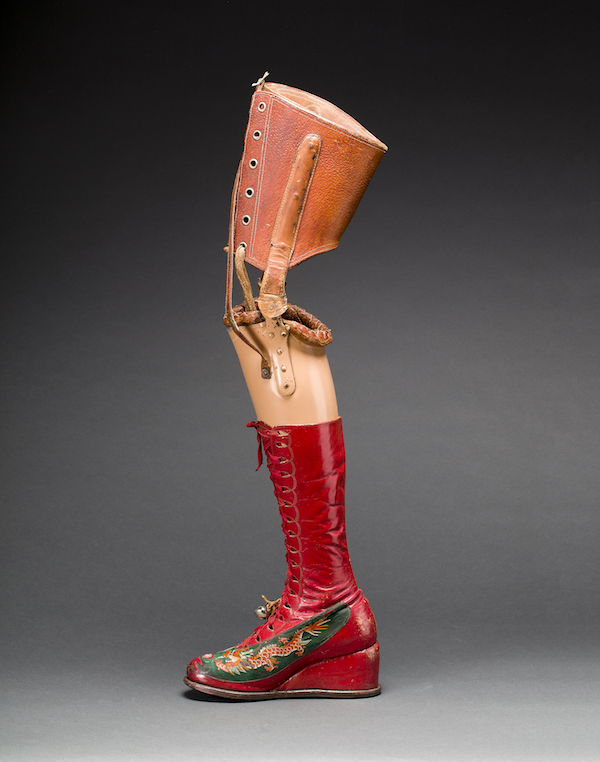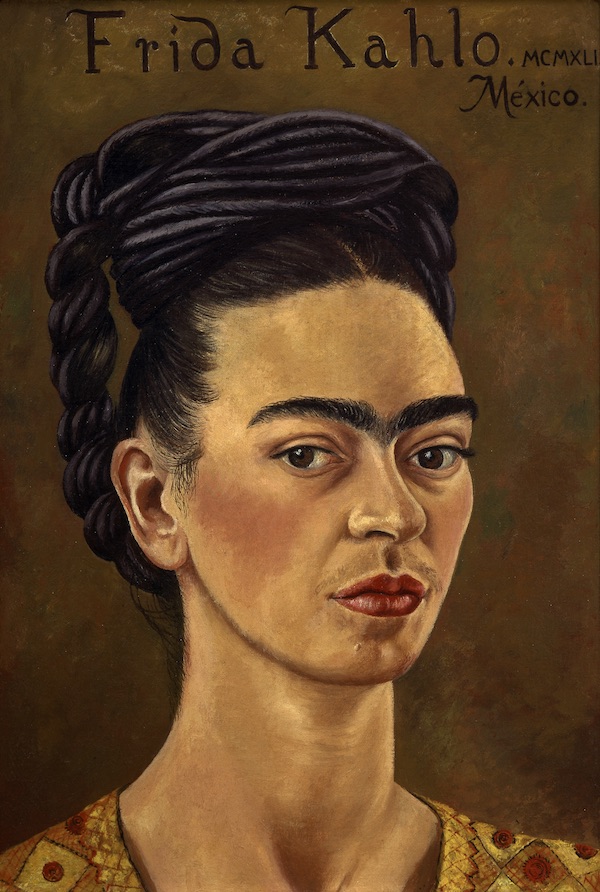When in 2004 Frida Kahlo’s bedroom – sealed on the command of her husband Diego Rivera for 50 years from her death – was opened, a trove of clothes and personal items was discovered. They shed new light on the life of this iconic Mexican painter and female artist, who, born in 1907 to a German father and Indian-Spanish mother, lived through the Mexican Revolution, the emergence of Communism and the accession of America to the position of world power.
As in her self-portraits which symbolically unpack states of being or dilemmas around her own likeness, Kahlo fashioned a highly personal world within the realms of the Blue House in Mexico City where she was born, lived and died and which is now a museum dedicated to her life and work. At the V&A coloured lighting, surreal cornices and a room-by-room soundtrack create an immersive experience which, if spatially inadequate for the number of visitors, is nevertheless highly effective at conveying the sense of slipping between highly subjective worlds that is so present in her paintings.
 What’s also made apparent is how close to the skin of things significance lay for Kahlo, how meaning resided in each action, each choice, each item. Early on there is a series of strikingly annotated family photographs (her father was a photographer), one with arrows and names directly scrawled on the print identifying family members; another of her christening with ¡idiota! added later on the back as an outraged annotation (as an adult she renounced Catholicism, evincing instead a syncretic interest in Taoism, Hinduism and indigenous beliefs). Later, a hand-drawn birds-eye map annotates the view of her beloved garden (towards her death she asked for her bed to be moved so she could view it better) and late in life her fingers dripped with rings she’d give away to friends as tokens of her affection – her hands literally symbolising friendship.
What’s also made apparent is how close to the skin of things significance lay for Kahlo, how meaning resided in each action, each choice, each item. Early on there is a series of strikingly annotated family photographs (her father was a photographer), one with arrows and names directly scrawled on the print identifying family members; another of her christening with ¡idiota! added later on the back as an outraged annotation (as an adult she renounced Catholicism, evincing instead a syncretic interest in Taoism, Hinduism and indigenous beliefs). Later, a hand-drawn birds-eye map annotates the view of her beloved garden (towards her death she asked for her bed to be moved so she could view it better) and late in life her fingers dripped with rings she’d give away to friends as tokens of her affection – her hands literally symbolising friendship.
But moving a house exhibition to another context will always be difficult, and there’s something about these personal effects being out of their original context which doesn’t quite translate. A further difficulty is that they are clearly used as a run-up to the climax of the exhibition – a room magnificently full of her skirts, shawls and clothes – and the same might be said for the paintings on display, her work uncomfortably servicing her image rather than the other way round.
Moreover, the exhibition suffers somewhat for being overly schematic. Separate sections are dedicated to her clothes, to medicines, to orthopaedic corsets, to the retablos – vernacular paintings offered in churches as thanks – that she and Rivera collected. So each part is immensely clear but also somewhat dense, and connections between the way Kahlo lived, loved, dressed and worked are not so much fluidly drawn as starkly stated. The loose huipil blouses she favoured that were the beautiful corollary of the unbeautiful orthopaedic corsets which supported her spine and alleviated her pain are displayed separately; the flowing skirts that disguised her uneven walk and hid her leg (amputated the year before she died) are in a separate section to the part dedicated to the matriarchal Tehuana culture which she referenced in wearing them. Fashion and medicine in their own ways both alleviated her suffering while somewhat disguising her condition – palliatively from herself, sartorially from others – but in the exhibition they are considered quite separately.
 Sometimes though, her art, her physical frailty and her aesthetic choices come together in striking ways. This is clear in a photograph of her painting Self-Portrait with the Portrait of Doctor Farill, 1951, in front of which Kahlo and Farill replicate their depicted stances. The self-portrait was painted in gratitude for the multiple surgeries he conducted on her spine which alleviated her pain to the extent she was again able to work. Yet in the photograph there is a striking contrast between the fidelity with which Farill has been depicted and the stark distinctions between the painted and the living Frida: in paint, despite the dark print under her eyes suggesting fatigue, she is serene and poised; in the photograph she looks tense with pain, her brow concerned and visibly runched. The illusion is exploded, the layers of artifice temporarily peeled off.
Sometimes though, her art, her physical frailty and her aesthetic choices come together in striking ways. This is clear in a photograph of her painting Self-Portrait with the Portrait of Doctor Farill, 1951, in front of which Kahlo and Farill replicate their depicted stances. The self-portrait was painted in gratitude for the multiple surgeries he conducted on her spine which alleviated her pain to the extent she was again able to work. Yet in the photograph there is a striking contrast between the fidelity with which Farill has been depicted and the stark distinctions between the painted and the living Frida: in paint, despite the dark print under her eyes suggesting fatigue, she is serene and poised; in the photograph she looks tense with pain, her brow concerned and visibly runched. The illusion is exploded, the layers of artifice temporarily peeled off.
There’s a wealth of extraordinary personal artefacts on display, and reams of fascinating information. Highlights include a sumptuous Chinese skirt bought in amazement in San Francisco’s Chinatown; photographs by Kahlo’s then lover Julien Levy as she braided her hair; her prosthetic leg with a cheeky bell attached to the arch (pictured above), and animal doodles she and Rivera sent each other. Her only lithograph, Frida and the Miscarriage, 1932, is on display,as is the richly detailed Self-Portrait on the Borderline Between Mexico and the United States, 1932, (main picture) and the striking Self-Portrait with Braid, 1941. But her actual work seems somewhat crushed beneath a kind of hagiographic celebrity. It’s not that it’s not a compact, sumptuous exhibition but rather that – ironically – it gives more space to who she was and who she seemed to be than what she actually did.








![SEX MONEY RACE RELIGION [2016] by Gilbert and George. Installation shot of Gilbert & George 21ST CENTURY PICTURES Hayward Gallery](/sites/default/files/styles/thumbnail_125_x_125_/public/mastimages/Gilbert%20%26%20George_%2021ST%20CENTURY%20PICTURES.%20SEX%20MONEY%20RACE%20RELIGION%20%5B2016%5D.%20Photo_%20Mark%20Blower.%20Courtesy%20of%20the%20Gilbert%20%26%20George%20and%20the%20Hayward%20Gallery._0.jpg?itok=3oW-Y84i)





Add comment